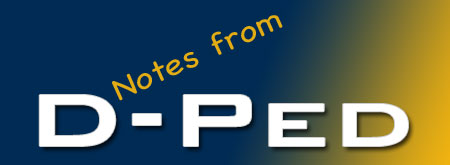
(Jennifer Holley, Aron Pease, John Harkey)
The nearly ubiquitous phrase “technology in the classroom” both invokes and elides a great deal. When we use this term—whether in an article, a job interview, or a hallway—we usually mean things like Twitter, blogs, course management software, or the actual computers that we or our students may use during a class session. In other words, “tech in the classroom” is often translatable as “digital pedagogy,” and indeed this is the central concept we intend to invoke: progressive newness—new media, new ways of teaching. Meanwhile, in our conversations about teaching with or through technology in the classroom, we tend to elide any technology and any notion of technology that’s “old,” that is, media that aren’t electronic, and more narrowly still, digital and screen-based.
At this point in D-Ped, we can take for granted that digital technologies are essential in today’s college classroom. Our presentation today is intended to create a space for reflection: we ask you to consider when and in what ways “low-tech” technologies can be useful in the classroom. We will begin the seminar with issues of practice. A student from Rebecca Burnett’s class will present work that has both “simple” and digital forms. D-Ped participants will then be asked to create a handmade project. What can be gained by asking our students to work in forms that require “simple” as opposed to high-tech skills? How can incorporating simple technologies inspire students to rethink their roles as communicators in a “digital age”? In other words, what can low-tech teach high-tech?
1. Materials to Bring to D-Ped This Week
Required: paper (any size or color), writing utensils
Optional: scissors, paper, tape, glue, markers, string, paper clips, crayons, yarn, stickers, photos, magazines, glitter, etc.
2. General Questions & Provocations
Is newer always better? If not, how do we determine when to use older stuff, and how do we articulate apologias to unfamiliar or skeptical parties?
Oppositions through which we might better understand the topic: digital vs. analog, immaterial vs. material (ambiguous and problematic but interesting), screen vs. page, simulation vs. reproduction, machine that simulates other machines vs. those other machines vs. machines that mechanically replace or extend (as prosthetics) the human body and its senses, pre-fab vs. DIY.
Units of measure: how do the techniques and habits of writing and reading change with the apparatus and the unit of writing and reading and thinking? (from the scroll to the page to the screen, and the variety of screens that simulate all of those things). Consider some well-known literary examples, like Nietzsche’s typewriter, Nabokov’s notecards, Kerouac’s scroll, Burroughs’s scissors.
What’so “hi-tech,” for example, about Pezi/Power Point anyway? The pre-fab software does the work for you, and you fill in the templates with content. We are reduced to content providers feeding an electronic writing machine (or monster).
Drawing on the “cyborg” trope, Charles Garoian and Yvonne Gaudelius (in the article linked below) even call for an “embodied pedagogy of resistance” (333) to the ways digital technology impinges on human bodies and identities. Their argument is predicated on the idea that digital media creates—to some degree—disorientation, “inertia,” and “oppressive conditions” (344) for individual subjects. Do our digital pedagogies tend to acknowledge and/or perform any resistance to these effects, or do they tend to merely perpetuate and/or reinforce such conditions?
Regarding “clarity” and “noise”: everyone’s interested in communicating more clearly; what’s wrong with a little noise?
3. Questions Regarding Pedagogy
Thinking back over your years as a student (any age), what was the best learning experience that involved “homemade” or “simple” technologies? What was the best learning experience that involved digital pedagogy? What made these educational experiences effective? Why are they memorable? What can we learn from our past experiences—and how can we integrate that knowledge into our classrooms?
What are the benefits of drawing attention to materiality? (or different materialities?)
What is the pedagogical significance of objects? How do object relations influence learning?
How might we find innovate ways to use simple, analog technologies in the classroom? Likewise, how might we radically repurpose simple, cheap, even discarded “objects” (including pieces of audio, video, or text) in the classroom, thus bringing critical attention to what is habitually overlooked and denigrated?
What is at stake affectively—thus also cognitively—in a class where, for example, the professor has energetically and dogmatically decided to “go paperless”?
What do “low tech” approaches have to offer, and can they be productively combined with high-tech approaches?
4. Suggestions for Viewing & Reading
Please watch the following 4-minute video and consider how homemade, low-tech, and digital forms of creation and communication work independently and in conjunction with each other.
The Façade Project: http://youtu.be/VIORAQ4Bs8o
Please read at most 333-38 and 343-46 from the article below, focusing on the latter (final) section.
Title: Cyborg Pedagogy: Performing Resistance in the Digital Age
Author(s): Charles R. Garoian; Yvonne M. Gaudelius
Source: Studies in Art Education, Vol. 42, No. 4 (Summer, 2001), pp. 333-347
Publisher(s): National Art Education Association
Stable URL: http://www.jstor.org/stable/1321078
Emphatically Non-Required Reading: here are a few more relevant pieces, presented merely for those interested in further exploring.
Article that addresses the array of media implicit in “multimodality”:
Title: Pedagogy, Connectivity, Multimodality, and Interdisciplinarity
Author(s): Carmen Luke
Source: Reading Research Quarterly, Vol. 38, No. 3 (Jul. – Sep., 2003), pp. 397-403
Publisher(s): International Reading Association
Stable URL: http://www.jstor.org/stable/4151827
Relevant Pieces from “The Chronicle”:
http://chronicle.com/blogs/innovations/students-and-technology-in-the-classroom/28549
http://chronicle.com/blogs/profhacker/going-paperless-in-the-classroom/31402
http://chronicle.com/article/College-20-Reaching-the-Last/123659/
Noteworthy example of an assignment that combines and foregrounds questions of physical composition and digital rendition:
http://macaulay.cuny.edu/eportfolios/bernstein10/category/artistic-encounters/collage-project/
